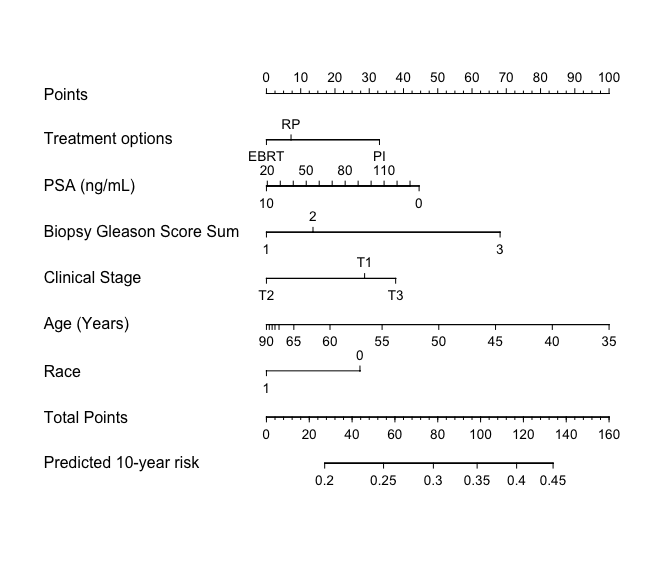Construct Nomograms for Competing Risks Regression Models.
QHScrnomo 
Nomograms serve as practical, useful tools and communication devices in the context of clinical decision making that enable clinicians to quickly understand and gauge individual patients’ risk of outcomes from (potentially) complex statistical models. The goal of QHScrnomo is to provide functionality to construct nomograms in the context of time-to-event (survival) analysis in the presence of competing risks. It also contains functions to build, validate, and summarize these models.
Installation
You can install the development version of QHScrnomo from GitHub with:
devtools::install_github("ClevelandClinicQHS/QHScrnomo")
Or from CRAN:
install.packages("QHScrnomo")
Dependencies
This package has its most prominent dependencies on the rms package. In fact, it actually Depends on it (see DESCRIPTION), so that package will load with QHScrnomo. It also makes heavy usage of cmprsk and Hmisc (which comes with rms). All methodology implemented here comes from these packages, so they should serve as a resource to further understand what is happening behind the scenes of QHScrnomo.
Example
The following is an example of how to construct a nomogram from a competing risks regression model. First, we’ll load the package.
library(QHScrnomo)
#> Loading required package: rms
#> Loading required package: Hmisc
#>
#> Attaching package: 'Hmisc'
#> The following objects are masked from 'package:base':
#>
#> format.pval, units
#> Loading required package: survival
#> Loading required package: lattice
#> Loading required package: ggplot2
#> Loading required package: SparseM
#>
#> Attaching package: 'SparseM'
#> The following object is masked from 'package:base':
#>
#> backsolve
1. Fit the regression model
Start by fitting a Cox proportional-hazards model.
# Register the data set
dd <- datadist(prostate.dat)
options(datadist = "dd")
# Fit the Cox-PH model for prostate cancer-specific mortality
prostate.f <- cph(Surv(TIME_EVENT,EVENT_DOD == 1) ~ TX + rcs(PSA,3) +
BX_GLSN_CAT + CLIN_STG + rcs(AGE,3) +
RACE_AA, data = prostate.dat,
x = TRUE, y= TRUE, surv=TRUE, time.inc = 144)
Then convert (adjust) it to account for the presence of competing risks.
# Refit to a competing risks regression to account for death from other causes
prostate.crr <- crr.fit(prostate.f, cencode = 0, failcode = 1)
anova(prostate.crr)
#> Wald Statistics Response: Surv(TIME_EVENT, EVENT_DOD == 1)
#>
#> Factor Chi-Square d.f. P
#> TX 5.21 2 0.0739
#> PSA 3.85 2 0.1458
#> Nonlinear 3.79 1 0.0515
#> BX_GLSN_CAT 15.29 2 0.0005
#> CLIN_STG 6.88 2 0.0320
#> AGE 9.27 2 0.0097
#> Nonlinear 1.35 1 0.2445
#> RACE_AA 3.21 1 0.0730
#> TOTAL NONLINEAR 5.16 2 0.0758
#> TOTAL 44.64 11 <.0001
2. Validate model output
We can generate cross-validated risk predictions at a particular time horizon of interest.
# Generate the cross-validated probability of the event of interest
set.seed(123)
prostate.dat$preds.tenf <- tenf.crr(prostate.crr, time = 120, trace = FALSE) # 120 = 10 years
str(prostate.dat$preds.tenf)
#> num [1:2000] 0.374 0.376 0.277 0.372 0.394 ...
And then check the discrimination of those probabilities via the concordance index.
with(prostate.dat, cindex(preds.tenf, EVENT_DOD, TIME_EVENT, type = "crr"))["cindex"]
#> cindex
#> 0.5711435
3. Construct the nomogram
Finally, we can build the nomogram that can be used to quickly generate model predictions manually.
# Set some nice display labels (also see ?Newlevels)
prostate.g <-
Newlabels(
fit = prostate.crr,
labels =
c(
TX = "Treatment options",
PSA = "PSA (ng/mL)",
BX_GLSN_CAT = "Biopsy Gleason Score Sum",
CLIN_STG = "Clinical Stage",
AGE = "Age (Years)",
RACE_AA = "Race"
)
)
# Construct the nomogram
nomogram.crr(
fit = prostate.g,
failtime = 120,
lp = FALSE,
xfrac = 0.65,
fun.at = seq(0.2, 0.45, 0.05),
funlabel = "Predicted 10-year risk"
)

